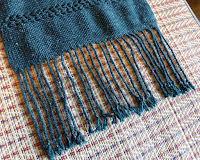 |
| Breezy Net Lace |
This pattern is a multiple of 6 stitches plus 4; the plus-4 is for two garter stitches at the edges of the piece, but you could of course have as many or as few garter stitches as you wanted. It is a four-row repeat.
Breezy Net Repeating Lace Pattern
Start by casting on as many stitches as you need for the width of your piece size as if you were knitting it in garter stitch.
This version of the pattern includes two garter stitches on either edge of the piece.
1st round: K2, *yo, k3tog, yo, k3, repeat from * to last 2 sts, k2.
2nd round: K2, k2, k2tog, yo, k1, yo, *k2tog, k1, k2tog, yo, k1, yo, repeat from * to last 9 sts, k2tog, k1, k2tog, yo, k2, k2.
3rd round: K2, *k3, yo, k3tog, yo, repeat to last 2 sts, k2.
4th round: K2, k2, yo, *k2tog, k1, k2tog, yo, k1, yo, repeat to last 6 sts, k2tog, k2, k2.
 |
The stole, partially stretched to show
lace pattern.
|
 | ||
The pattern from a little farther away.
|























